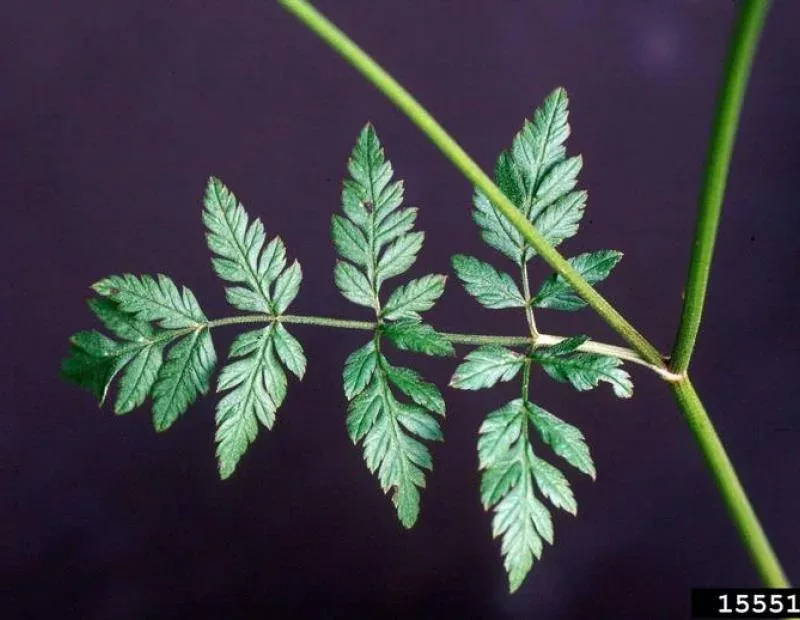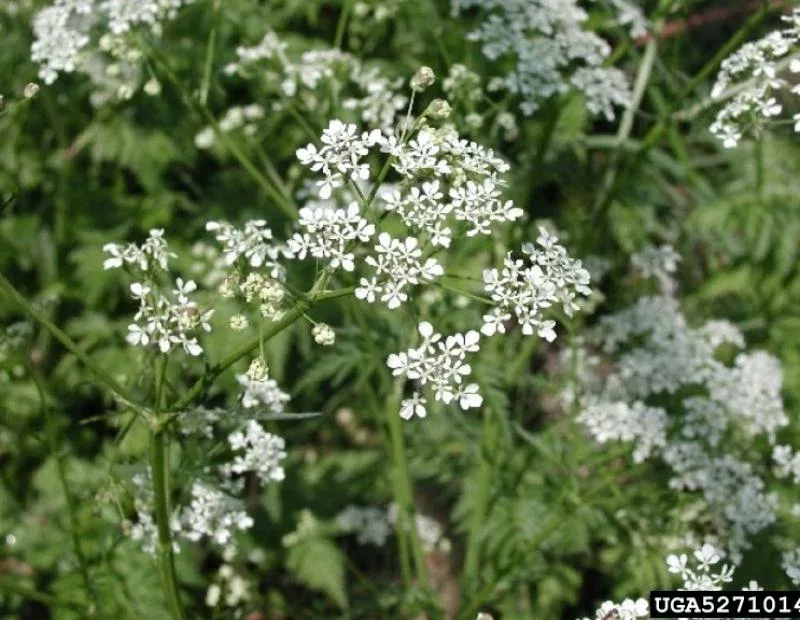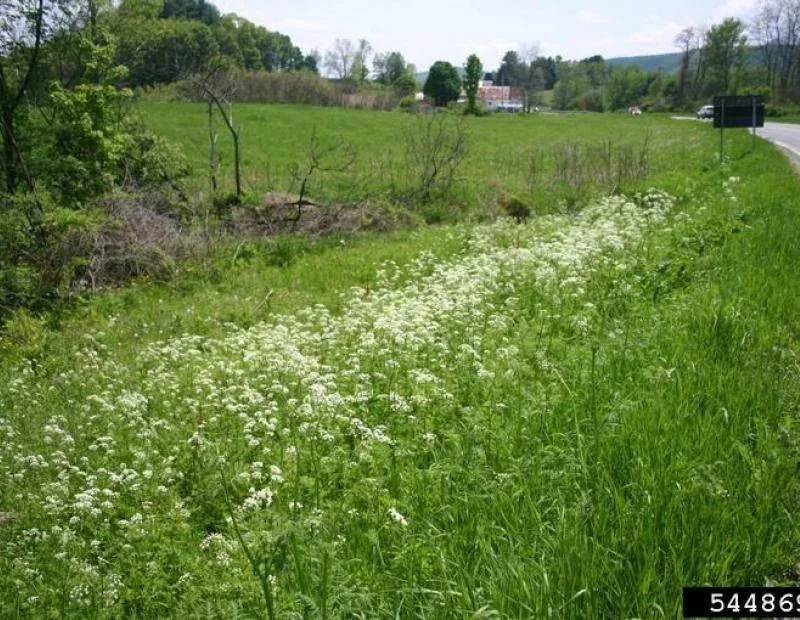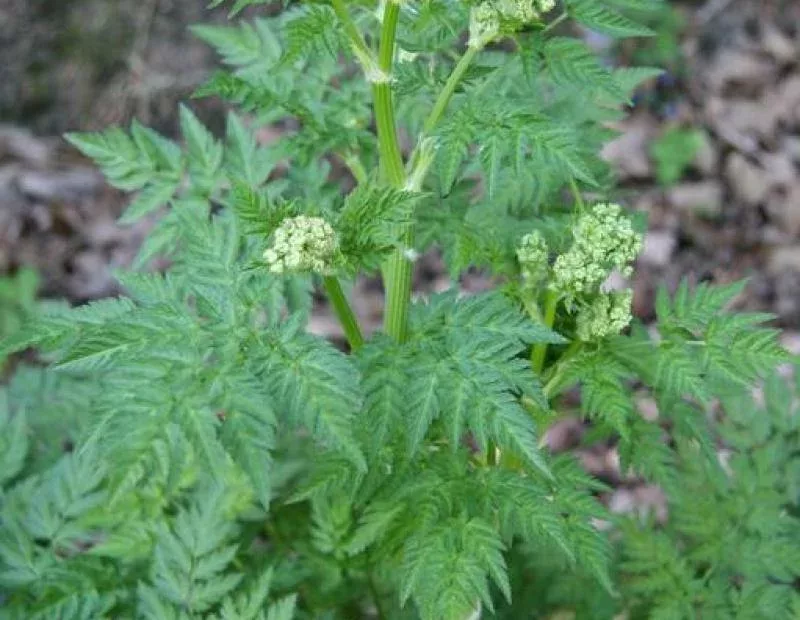
Wild chervil is a member of the Carrot family (Apiaceae).
A member of the carrot family, wild chervil exhibits many of the family’s characteristics, including an airy, white umbel of flowers appearing in late spring. Growing up to three and a half feet in height, when in bloom en masse along roadsides and in fields little else is visible amongst it.

Wild chervil colonizes riparian corridors, disturbed woodlands, fields, and other waste-places such as roadsides.
Leaves are highly divided, alternately arranged, and fern-like. As with all members of the carrot family the leaves have a sheathing, clasping leaf base.

Notched, five petaled flowers occur in small bunches to create a diaphanous, white umbel held on a hollow, hairy stem. Flowers become small, dry, elongate fruits.

Although wild chervil seed production is abundant (800- 10,000 seeds per plant), most seed falls close to the parent plant and will live in the seed bank for only one winter. (6) Wild chervil is able to form smothering, homogeneous stands problematic for other native species due to a deep taproot and rapidly spreading lateral rhizomes.(2) Vectors invlude wind, water, birds, mammals and humans. (6)

Wild chervil is a spring blooming perennial belonging to the carrot family. Capable of spreading rapidly via underground rhizomes and copious amounts of seed, infestations of wild chervil significantly alter the herbaceous layer, outcompeting native plants and decreasing plant diversity.


No biological control option is currently available.
Pulling / Digging Up Hand pulling or digging young plants or rosettes is effective, if time consuming. (3) Care must be taken to remove the taproot, otherwise, re-sprouting can occur. (4)
Mowing: Cutting at time of flowering has been shown to decrease this species’ capacity for vegetative growth and spread. It is even more effective if performed repeatedly, once the plants produce a second round of flowers. Utmost care must be taken to complete control before the formation of fruit as mowing is one of the primary means this species spreads throughout the region. (7).
Girdling: Not applicable
Prescribed Fire: No information available
Prescribed Grazing: Wild chervil is palatable to cattle and sheep and grazing has been shown to suppress the species somewhat. Repeated trampling appears, however, to have no effect. (8)
Soil Tilling: Tilling is not a recommended method of control as wild chervil often colonizes fragile, wet soils vulnerable to erosion and can re-sprout from root fragments.
Mulching: Not advised. Wild chervil has been shown to be extremely tolerant of low light levels at germination and is capable of surviving in dense grasslands (8)
Solarization: Not applicable
Hot Foam Spray: No information available
The pesticide application rates and usage herein are recommendations based on research and interviews with land managers. When considering the use of pesticides, it is your responsibility to fully understand the laws, regulations and best practices required to apply pesticides in a responsible manner. At times, the pest you seek to treat may not be on a pesticide label, requiring a 2ee exemption from NYSDEC. Always thoroughly read the label of any pesticide and consult the NYSDEC or a licensed pesticide applicator with questions.
Foliar Spray: Wild chervil has demonstrated resistance to several types of herbicide. (9) Both Dicamba and glyphosate are effective if applied post emergence in spring. Imazapyr and Metsulfon containing products have also been proven effective. In all cases, repeat spraying will likely be necessary.(10)
Cut Stump: Not applicable
Basal Bark: Not applicable
Hack-And-Squirt: Not applicable
Stem Injection: Not applicable
Pre-Emergent Spray: No information available
General management overview and recommendation
As a short-lived perennial with a short-lived seed bank, wild chervil can be managed quickly and effectively by hand pulling or mowing if populations are discovered early. Consideration must be given to the wet, often vulnerable sites wild chervil colonizes, such as frequently disturbed stream banks. For large populations, repeated mowing (at least 3 times a season, at flowering onset) or foliar spray is the most effective management option.
Post treatment monitoring
Controlled populations should be revisited at least 2-3 times a season for at least 2-3 years to ensure exhaustion of the seed bank and that no re-sprouting has occurred.
Disposal Methods
Mowed, cut, or pulled wild chervil can be composted so long as the seed is not full, ripe, and therefore viable. Stems and rhizomes should be crushed, or allowed to dry out completely, before composting in order to prevent regrowth.
